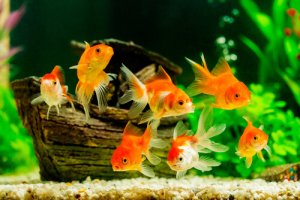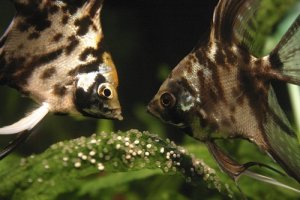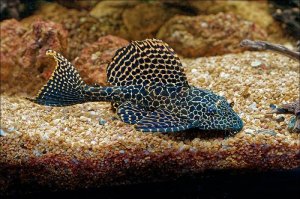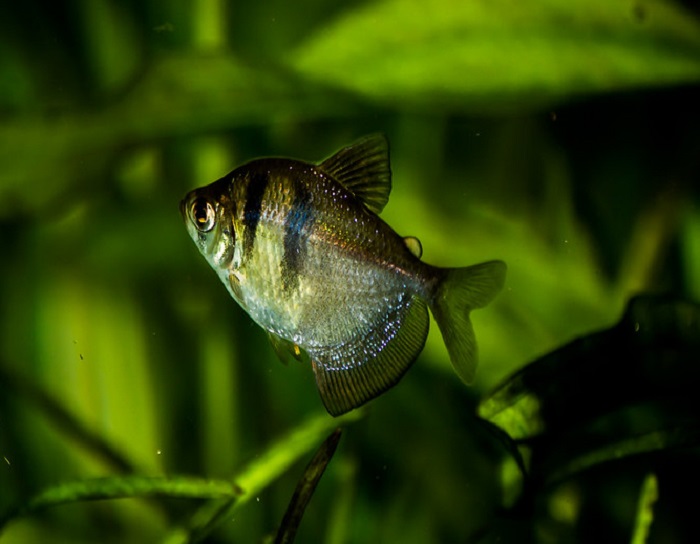
A very popular freshwater Aquarium fish, recommended for knowledgeable beginners and intermediate hobbyists, is the Black Skirt Tetra, not to be confused with the Black Tetra, which I will describe further on. Caring for a Black Skirt tetra is fairly easy, they are peaceful and active shoaling fish that are ideal for communal tanks, and they are reasonably hardy fish, so let’s get to know them better.
Breed Overview
| Origin | Bolivia, Brazil, Northern Argentina |
| Lifespan | 3-5 Years |
| Size | 5cm (3 Inches) |
| Colors | Black, White, Albino |
| Food | Omnivore |
| Tank Size | 15 – 20 Gallons for 6 fish |
| Temperament | peaceful, Active, Anxious |
| Water Type | Freshwater |
| Water Temperature | 78°F – 86°F (26 ̊ C – 30 ̊ C) |
| Water pH | 0 – 7.5 |
| Difficulty Level | Easy to Intermediate |
Black Skirt Tetra Species Summary
The Black Skirt tetra, often referred to as the Butterfly Tetra, Black Tetra, or Black Widow Tetra, is a species of Tetra fish native to Bolivia, Brazil, and Northern Argentina, roaming the river basins and water levels.
Scientifically known as “Gymnocorymbus Ternetzi”, it is a freshwater fish from the Characidae family, consisting of tropical and subtropical Freshwater fish. The Black Skirt Tetra is well known as a schooling fish that enjoys company, has a peaceful nature, and has an omnivorous diet.
Color Variations In The Black Skirt Tetra
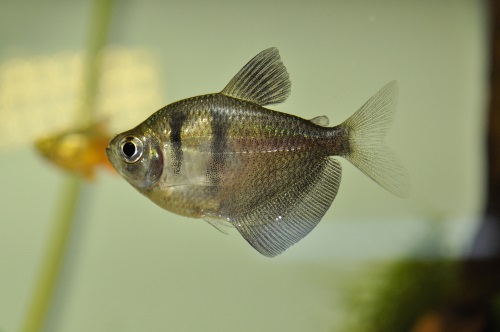
The Black Skirt Tetra is named as such because of the prominent darker shade to the posterior of the body, and black fins. The rest of the body will usually be silver with vertical bars on the sides.
- Males And Females – Male and Female Black Skirt Tetra have relatively the same coloration, with the females being larger than males with a rounder body, and the males having a wider anal fin and narrower dorsal fin.
- Genetic Modification – You may notice the “Glow Fish” species in many pet stores, which are essentially tetras that have been genetically modified to have fluorescent colors. The fish are dyed or fed a diet of highly pigmented foods to change their color, both these practices are unethical and unhealthy for the fish.
- Color Variations – Other color variations available are the White Skirt Tetra which appears almost entirely pink with translucent fins and the Albino Black Tetra, which is a very rare species, where it only differs in color.
Black Skirt Tetra Lifespan And Size
The Black Tetra only reaches sexual maturity around two years of age and has a lifespan of between 3 to five years in captivity. They are generally 7.5cm (3 Inches) in size when fully mature.
Temperament And Behaviour
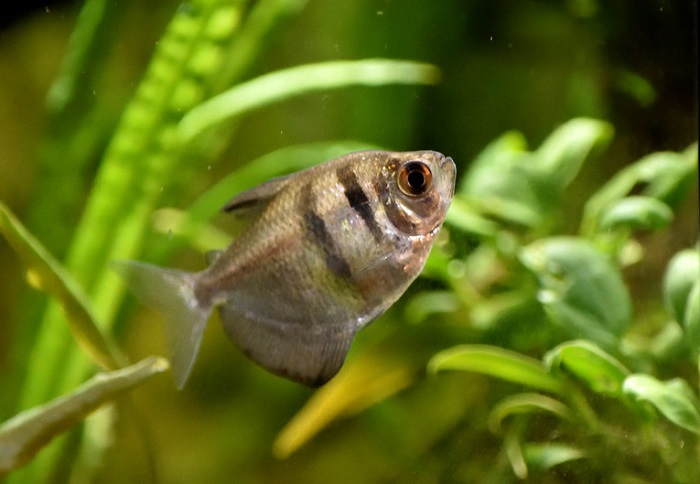
Black Skirt Tetras are fast, lively, and sociable, shoaling fish that will be peaceful, and enjoy being in a group where they can chase, and play with each other.
Though they tend to get anxious quickly when they feel threatened in their environment, and that is why they need a more dimmed aquarium with plenty of vegetation.
As they mature Black tetras will become calmer and less lively than in their youth. With other species’ tank mates, they usually get along easily with peaceful fish, though may nip at the fins of fish with longer fins such as Guppies.
General Care
When it comes to caring for Black Tetras I would advise someone that has slightly more experience, especially with setting up the tank. The right aquarium environment can make a huge difference to the health and behavior of Black Tetras, as I have stated that they can be apprehensive at times. So, here’s a guide to the perfect tank set-up for your Black Skirt Tetras:
Creating Your Aquarium
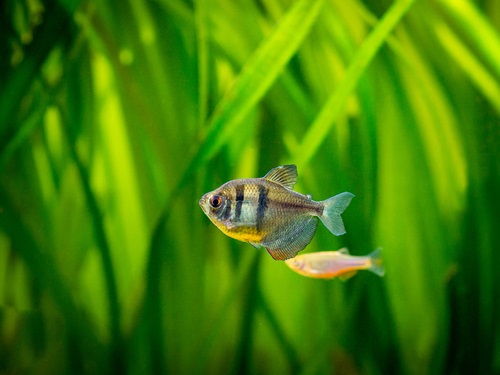
Firstly, they will need a tank that is around 15 to 20 gallons, and it’s crucial to keep a group of at least 6 fish, though the more the merrier. They thrive in dim light and more shaded areas, with thick planting, and soft filtered, warm water that has a moderate current.
- Water Conditions – Black Tetras require slightly acidic soft water that is clean, with a pH level of around 6.8 – 7.5, and water hardness of 4.0 – 8.0 dKH. Temperatures between 78°F – 86°F (26 ̊ C – 30 ̊ C) are ideal, although they can tolerate slightly lower temperatures, not below 70°F (21 ̊ C).
- Filtration – Though they do not produce excessive waste, if you have a larger school of Tetras it can quickly alter the quality of your water. A strong filtration system is crucial, to keep Ammonia and Nitrate levels down. Black Skirt Tetras thrive in the cleanest water, with a moderate current. For a very large tank, I recommend a bottle filter, otherwise a Hang On Back filter will be suitable.
- Heater – Unless you live in a tropical climate where the temperatures will not drop below 70°F (21 ̊ C), I would strongly advise a heater, especially for winter months. Because Black Skirt Tetras similarly enjoy more shaded areas, a heart will be needed. Generally, when they are cold, they will become lethargic, and when overheated they become stressed and ill. An internal or external heater that is 150 watts for 20-30 gallons of water is suitable, just keep an eye on the temperatures, using a reliable thermometer.
- Light – I have spoken about light a few times as it is a vital part of your tank set-up for Black Skirt Tetras. They prefer low light, so opt for an adjustable light or low light area in your home. Switch lights off at night to allow them to sleep.
Decorating Your Tank
Luckily the ecosystem that Black Skirt tetras are used to in the wild is swarming with life, so you can become very creative with their tank, and even try your hand at proper Aquascaping. One of the most important decorations for a Black Skirt Tetra Aquarium is Live Plants and plenty of them!
On the other hand, they are very active swimmers and thus will need enough center space for swimming in the midsection of the tank.
- Substrate – Similarly in contrast to their need for shade, and to mimic their natural habitat, dark gravel or sand substrate is advised.
- Ornaments – Your black tetras will enjoy a few hiding spots such as caves, and more natural ornaments, including driftwood and rocks.
- Synthetic Plants – Ideally I do not recommend synthetic plants, as most tetras will also feed on plants in their tank. Though, if you are inclined to synthetic plants, ensure they are soft silk and fabric plants that will not cause injuries to your fish.
- Live Plants – Crucial for a happy and healthy tera is a heavily planted tank with natural plants.
Some easy choices that are also more readily available include:
- Amazon Swords
- Java Moss
- Java Ferns
- Polysperma
- Water Wisteria
- Amazon Frogbit
- Guppy Grass
Generally long stemmed plants are ideal, and try to keep most plants and ornaments to the edges of the tank, and not too dense, to allow for active swimming. As you will notice I have included some floating plants to help mute the light in your tank.
Lastly, keep a lid on your tank, as these active little critters may just decide to be overzealous and jump out!
Introducing Your New Fish
When your tank is fully decorated and cycled for at least 2 days, I would advise using a testing kit to check water parameters, and also check the temperature before introducing new fish. You will need a group of between 6-10 Black Skirt Tetras with males and females mixed.
Choosing Healthy Black Skirt Tetra Fish
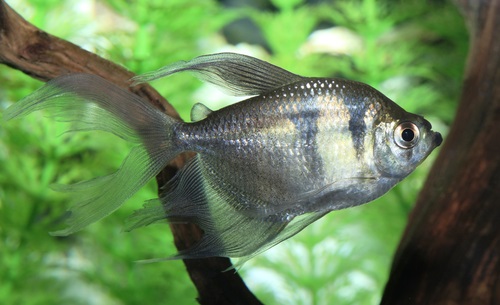
Make sure that you purchase fish from a trusted pet store or breeder, and look for the following signs of health:
- Bright dark eyes with no white or milky coloring.
- A normal belly that is not bloated indicating digestive issues.
- Swimming actively and not hiding or cowering in a corner indicates stress.
- No patches, protrusions, or damage to the skin and fins, the colors need to be bold and not dull or brownish.
Placing Fish In The Tank
To reduce stress and safely place your new fish in their home you can follow these steps;
- Place your new fish in their bag to float in the tank for around 20 minutes to acclimate.
- Remove a cup of water from the bag and replace it with water from the tank.
- Repeat step 2 at 15-minute intervals for around 30 minutes or more.
- Use a net or gently allow the fish to swim from the bag into the tank, avoiding too much water from the bag entering your tank, as it may contain large amounts of ammonia.
Tank Mates
With regards to tank mates, some Black Skirt Tetra and Betta Fish owners find that males are constantly fighting in communal tanks. Therefore to play it safe, here are a few suitable tank mates that avoid this problem entirely:
| Celestial Pearl Danios | Horsehead Loaches |
| Neon Tetras | Kuhli Loaches |
| Dwarf Gouramis | Corydoras Catfish |
| Harlequin Rasboras | Nerite Snails |
| Bolivian Ram Cichlids | Pygmy Corydoras |
| Cherry Barbs | Pearl Gouramis |
| Cardinal Tetras | Honey Gouramis |
Tank mates such as Loaches, Corydoras, and snails also have the benefit of cleaning your tank and eating algae.
Feeding Black Skirt Tetra Fish
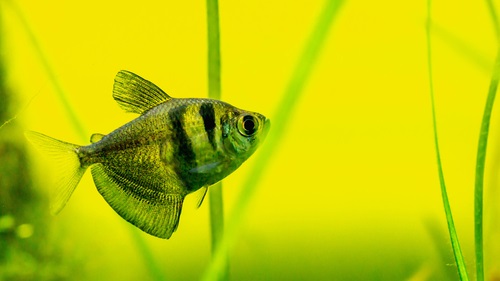
Though Black skirt tetras are omnivores, they are said to ideally enjoy a vegetable-based diet more than meat. Though they will need a varied diet with protein and plants consisting mostly of balanced flakes or pellets from a trusted source:
What To Feed
You can feed your Black Skirt Tetras a Varied plant and meat-based diet, with quality flakes and pellets.
- Pellets And Flakes – Good quality flakes and pellets are balanced and a nutritional staple for your fish.
- Live And Frozen Foods – Tetras enjoy life or freeze-dried meat-based foods such as; Brine Shrimps, Blood Worms, Black Worms, Daphnia, and Mosquito Larvae.
- Plant Material – You can include veggies such as; Spinach, Kale, Zucchini, Lettuce, Carrots, and Cucumbers in their diet. Just ensure that the vegetables are blanched and very finely chopped to prevent choking.
How To Feed
Most Black Skirt Tetras are enthusiastic eaters, though they do not eat much. You can feed them once or twice a day, and only as much as they can finish within a few minutes. It is recommended to use one feeding to feed them plant and vegetable-based foods as a snack, and one feeding for pellets or flakes.
Tank Maintenance And Tank Equipment
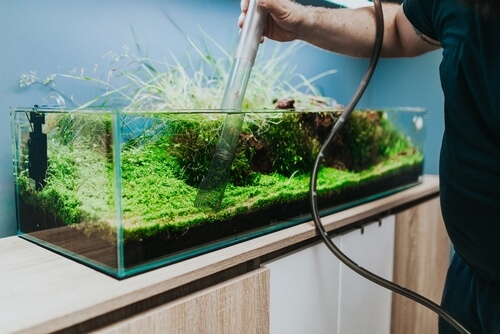
The Black Skirt Tetra thrives in ultra-clean water and thus, regular cleaning and water changes are a necessity.
- Do a weekly water change of at least 25% of the tank water, by siphoning with a hose from the bottom, and replacing it with fresh conditioned, and properly heated water.
- Use an algae pad or scraper to clean the sides of your tank, removing all the algae.
- A gravel vacuum is an ideal tool to clean your gravel monthly.
- Clean your tank ornaments and remove algae from them.
- Do not forget to clean the outside of your tank.
- Once a month the tank filter needs to be cleaned, and chemical media removed and replaced as needed.
Similarly, you may find that keeping bottom-feeding fish, and some snail species, will help to remove algae and uneaten foods from your tank. Live plants in turn help to oxygenate the water, and clean the water in your tank.
Common Health Issues In Tetras
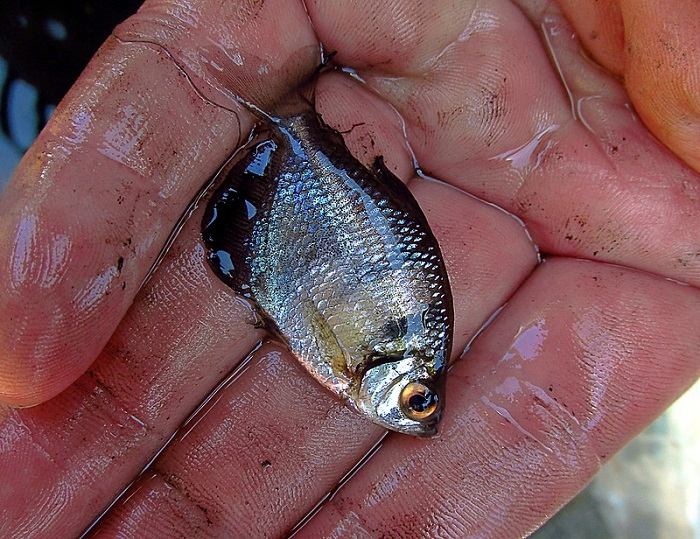
Black Skirt Tetras are quite sensitive, and prone to most regular freshwater fish diseases and pests if the right measures are not taken. By ensuring that their tank water parameters are always at optimal conditions and that they are fed a proper diet, you are already ahead in preventing disease and parasites.
Another issue is introducing new fish or plants that may have an infectious disease or pest, so be careful, and quarantine all newcomers initially.
Here are a few of the main Tetra fish health concerns:
1. Swim Bladder Disease
When there is a fungal or bacterial infection in the swim bladder organ of your fish, caused by many things they may get Swim bladder disease or Dropsy.
- Symptoms: You will notice that your fish struggles to stay upright and it may turn sideways, upside down, or float.
- Treatment: Swim bladder is treated by isolating your fish in a tank with clean water, and using antibiotics.
2. Fin Rot
Fin rot is an infection that will spread from the fins to the body of the fish, and is mostly caused by poor water conditions.
- Symptoms: You may notice discoloration and red streaks on the fins and body of your fish. The fins may similarly look ragged and torn.
- Treatment: isolation in clean water with good antibacterial medication is your best course of treatment.
3. Ich/White Spot Disease
A Protozoan parasite that causes white spots on your fish, many times increased with poor water conditions, and introduced by new fish or plants.
- Symptoms: You will notice white spots, especially near the fins and gills of your fish, and your fish may become lethargic, losing its appetite.
- Treatment: Ich is transmissible to other fish, so isolation is vital. Keep your fish in clean water with additional aquarium salts until the lifecycle of the parasite comes to an end.
Breeding
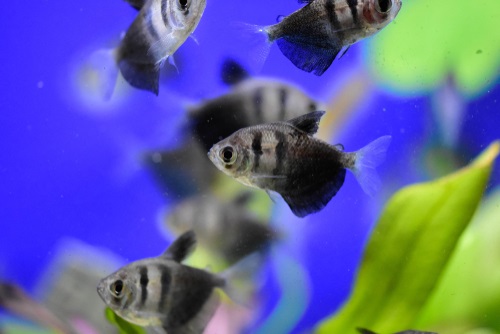
Black Skirt tetras are known as prolific breeders, which means that they produce a large amount of young. They are mainly egg scatterers, and not very good parents, as they will eat their eggs and young fry. You will need a separate breeding tank with suitable plants, or a spawning mop for the eggs to attach to.
Spawning takes place in groups of fish with one male per female, after spawning the parents must be removed or they will eat their eggs.
The eggs take around a day or two to hatch, with the young fry becoming dependent in 2-3 days, in which case you can feed them finely crushed foods or infusoria.
Final Thoughts
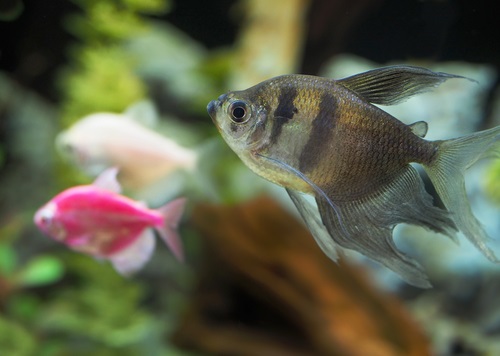
Finally, the Black Skirt Tetra is a splendid, energetic fish that is peaceful and can be social in the right circumstances. They are the perfect freshwater species to keep, if vigilant, and thorough care is taken when creating their aquarium, introducing companions, and keeping their tank clean.


